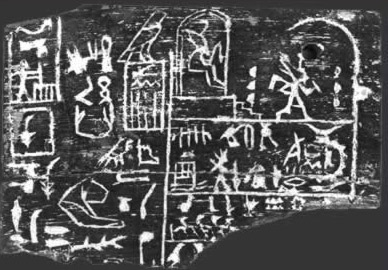Den, the 4th King of Egypt's 1st Dynasty
by Jimmy Dunn

While an early King, Den, who's name means "Horus Who Strikes" (Udimu), is perhaps better attested than some. We believe he served as the 4th King of Egypt's 1st Dynasty. He may have come to the throne at an early age, with his mother, Merneith, acting as regent.
He left a number of labels and inscriptions on stone vases which cite the king, including events during his reign. We have found seals impressions and inscriptions in tombs 3035, 3036, 3038, 3504, 3506, 3507, X and a lower status tomb at Saqqara, from a tomb at Abu Rowash and of course, from King Den's own Tomb at Saqqara.
His throne name has been identified as Semti which helps us identify him as a king in the Abydos King list named Hesepti. He is believed to have been the first king to adopt a nsw-bity (King of Upper and Lower Egypt) name, which was Khasty. According to Manetho, he had a reign of some 20 years. However, he may have celebrated a Sed-festival,
which usually occurred in the 30 year of rule, and some Egyptologists believe he may have reigned for as long as 50 years.

Though the reigns of Den's processor and successor seemed to have been troubled, the reign of Den was apparently a glorious and prosperous one. Yet beyond this prosperity, like Horus Djer before him, Den left behind an intellectual reputation. We believe that the spells found in the later funerary manual called the Book of the Dead was attributed to his time, as well as medical formulae that were preserved in New Kingdom papyri.
Den Apparently limited the power of high officials which had previously been allowed to grow dangerously strong during the reign of his predecessor. Such centralization always seems to have been key to a successful royal reign. However, we believe he also pursued a policy of conciliation with northern Egypt, probably creating a post of "chancellor of the King of Lower Egypt:, filled by a man named Hemaka.
Hemaka is a well known figure of this time who built an important tomb at Saqqara. The contents of this tomb provide us with our most comprehensive collection of 1st Dynasty funerary equipment. It is also from this tomb that we find possible evidence for Den's Sed-festival (along with a label found at Abydos, depicting the earliest known king wearing the double crown of Egypt).

Soon, however, it appears that Den turned his focus to military affairs. An interesting ivory label found at Abydos that was inscribed for Den records, "The time of the smitting of the East". It shows Den in the classic pharaonic posture, with his mace raised above his head about to club a foreign chieftain. This seems to correlate with the "Smiting of the Troglodytes" recorded on the Palermo stone.
We believe these campaigns included an incursion into the "Asiatic" (Palestine) territories, during his first year, where he bought back a harem of female prisoners. He also seems to have made a military expedition into the Sinai to deal with a (so called) Bedouin problem.
Den's tomb, notably excavated by Petrie in 1900 after having earlier been excavated by Emile Amelineau, has been identified as Tomb T at Abydos. Significantly, this tomb was the first we know of to utilized a significant amounts of granite in its construction. This consists of slabs of red and black granite from Aswan that was used to pave the burial chamber. In many ways, the tomb was one of the most impressive so far built in Egypt, and certainly at Abydos, with a proper stairway and a massive burial chamber that was once roofed with wood, perhaps retrieved during his Eastern military campaign(s).
The stairway, the first we find in an Egyptian tomb, was sealed with a wooden door, and just before the burial chamber was a portcullis barrier to block grave robbers. A small room to the south-west, with its own small stairway, may have been an early serdab, which was a chamber built to hold statues of the deceased. A German team who excavated the ruins (after a number of earlier excavations) revealed that grave goods or fragments included pots with seal impressions, stone vessels, inscribed labels and other carved objects in ivory and ebony, as well as inlays from boxes and furniture. A long side chamber probably held jars of wine. Near the tomb were found 136 subsidiary burials.
However, one of his queens was probably buried at Giza, and her tomb is larger than that of her husband's. It also included graves of sacrificed servants around it, but unfortunately, her name is not know.
References:
| Title | Author | Date | Publisher | Reference Number |
| Chronicle of the Pharaohs (The Reign-By-Reign Record of the Rulers and Dynasties of Ancient Egypt) | Clayton, Peter A. | 1994 | Thames and Hudson Ltd | ISBN 0-500-05074-0 |
| History of Ancient Egypt, A | Grimal, Nicolas | 1988 | Blackwell | None Stated |
| Monarchs of the Nile | Dodson, Aidan | 1995 | Rubicon Press | ISBN 0-948695-20-x |
| Oxford History of Ancient Egypt, The | Shaw, Ian | 2000 | Oxford University Press | ISBN 0-19-815034-2 |

